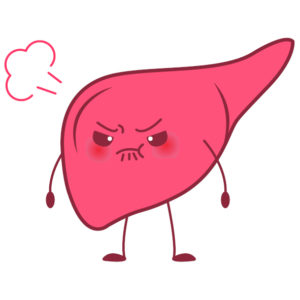Viral hepatitis
Hepatitis is used to describe inflammation of the liver and can be caused by just one or many factors, e.g. viral infection, alcohol consumption, fatty deposits in the liver.1 Viral hepatitis is commonly referred to as either Hepatitis A, B, C, D or E. The letter that follows ‘hepatitis’ depends upon the type of virus present. These five types are of greatest concern because of the burden of illness and death they cause and the potential for outbreaks and epidemic spread.
Hepatitis A
Hepatitis A is a waterborne virus, and generally occurs in poo, which finds its way into the mouth.1, 2 This is usually via contaminated food or water. It is most widespread in parts of the world with poor sanitation and food hygiene, such as parts of Africa, the Indian subcontinent, the Far East, the Middle East, and Central and South America.1,2 For most people, hepatitis A will pass within two months and there will be no long-term effects.1 Once it passes, you normally develop life-long immunity against the virus. For around 1 in every 7 people with the infection, the symptoms may come and go for up to 6 months before eventually stopping.2 Although hepatitis A isn’t usually serious, it’s important to get a proper diagnosis to rule out more serious conditions with similar symptoms, such as hepatitis C or cirrhosis (scarring of the liver). 2
Vaccination against hepatitis A is recommended if you’re at high risk of infection, face severe consequences of infection, or you’re travelling to an area where the virus is common, such as the countries and locations listed above.1
Blood-borne viruses : Hepatitis B and C
The hepatitis B and C viruses are deemed to be blood-borne viruses (BBV) and are carried in the bloodstream to the liver, where they can potentially cause damage. Collectively, it is estimated that hepatitis B and C cause 1.3 million deaths per year – more than HIV/AIDS, tuberculosis or malaria3 and are responsible for 2 out of 3 liver cancer deaths.3
It is also estimated that more than 300 million people are infected with the hepatitis B virus or the hepatitis C virus.3
Hepatitis B
This is a DNA virus whose infection happens mainly through blood (substance abuse, intravenous, tattoo, piercing), sexual contact and through “vertical transmission” (mother to child) during birth. Transmission through blood transfusion and non-sterile equipment remains relatively rare in industrialized countries.
Hepatitis B is highly infectious and is estimated to be 50-100 times more infectious than HIV.5 Infection of the virus can be either acute (short-term) or chronic (persistent).
To prevent the transmission of the virus to another person, it is vital that precautions are taken to ensure that no one is at risk of contact with infected blood. The hepatitis B virus can remain ‘live’ in dried blood for a number of days, possibly weeks.5, 6 Hepatitis B is not spread by contaminated food or water, nor through social contact hugging, holding hands.
Symptoms of hepatitis B can develop within 1-6 months (incubation period) and can include: nausea, vomiting, fever, fatigue, yellowing of the skin and whites of the eyes, dark urine, pale stools, general feeling of ‘unwell’.4 Approximately 90% of all healthy adults will clear HBV within 3-6 months and the immune system will then prevent further infection.4
For the minority who aren’t able to clear HBV, it is deemed a chronic infection. Treatment may be necessary and the individual will continue to be infectious.
Babies and children with hepatitis B are more likely to develop a chronic infection. The virus remains long-term in over 90% of babies infected from their mothers, unless they receive an antibody injection and standard immunisation at birth.4
Only 5% of people infected with hepatitis B will go on to develop a chronic infection.4
You can go to your local doctor’s surgery, drug service, genitourinary medicine (GUM) clinic or sexual health clinic for help and advice. A blood test can be carried out to check if you have hepatitis B or have had it in the past. The hepatitis B vaccine may also be recommended to reduce your risk of infection if you do not have the virus but remain at high risk of exposure.
There is no specific treatment to clear acute HBV from the body, nor is there treatment which will prevent it from becoming persistent, but keeping hydrated and taking pain relief will ease some of the symptoms. NB: alcohol and smoking should be avoided.7 Treatment for chronic HBV aims to stop or reduce the activity and replication of the virus, thus limiting the damage to the liver. A hepatologist (liver specialist) or gastroenterologist will advise on treatment, which is usually long-term.7
If the HBV causes severe damage to the liver and the scarring is advanced (cirrhosis), a transplant may be an option.8
The prognosis can be very good, but it must be remembered that the new liver may also eventually become damaged by the persistent HBV. Lifestyle changes should be made by anyone suffering from chronic HBV, whereby a healthy balanced diet should be adhered to. Alcohol consumption and smoking should be avoided completely as these factors will increase the risk and speed of developing cirrhosis. The liver will already be inflamed due to the presence of the hepatitis B virus.7
Hepatitis C
HCV is an RNA virus that is transmitted through blood-to-blood contact. Historically, most patients with this virus were infected through blood transfusions. Now that the blood supplies are screened for HCV, the most common cause for new cases is intravenous drug use. While sexual transmission of the virus can occur, it is very rare as the virus is not transmitted in semen or saliva. Given that the virus can exist in the body for a long time, many people infected with HCV are unaware of how they contracted it.
Just a small trace of blood can cause an infection. At room temperature, it’s thought the virus may be able survive outside the body in patches of dried blood on surfaces for up to several weeks.9 It has been reported that Hepatitis C has been found in other bodily fluids, e.g. vaginal fluid and semen. However, the risk is higher if fluids are contaminated with blood, e.g. as in rough sex where blood might be present.10
To prevent transmitting the virus to another person, it is vital that precautions are taken to ensure that no-one is at risk from contact with infected blood. 1 in 5 people infected with hepatitis C will naturally clear the virus. For the remaining 80%, they may be able to clear it through treatment.11 Either way, it is possible to become virus-free, but the antibodies will not provide immunity to future transmissions.
Symptoms of hep C may develop within 1-6 months (known as the incubation period) and can include: nausea, extreme tiredness, problems concentrating (brain fog), yellowing of the skin and whites of the eyes, dark urine, pale stools, general feeling of ‘unwell’, discomfort in the liver area. In most cases, it causes no noticeable symptoms until the liver has been significantly damaged. When symptoms do occur, they are often vague and can be easily mistaken for another condition.12
The hepatitis C virus is diagnosed from a specific blood test, usually following an abnormal Liver Function Test (LFT) result, and/or the patient presenting with symptoms and risk factors. There is no vaccine for HCV.
If the virus persists after six months, further blood tests will be undertaken to establish the viral load and genotype. There is no specific treatment to clear acute HCV from the body, nor is there treatment which will prevent it from becoming persistent, but keeping hydrated and taking pain relief will ease some of the symptoms. Alcohol and smoking should be avoided.
Treatment for chronic HCV aims to achieve a sustained virological response (SVR), which means that the virus is undetectable after six months from completing the treatment. A hepatologist (liver specialist) or gastroenterologist will advise on current treatment. If treatment is not effective or if treatment hasn’t been an option, a transplant may be required. The prognosis can be very good, but it must be remembered that the new liver may also eventually become damaged by the persistent HCV.13
Lifestyle changes should be made by anyone suffering from chronic HCV, whereby a healthy balanced diet should be followed. Alcohol consumption and smoking should be avoided completely as these factors will increase the risk and speed of developing cirrhosis. The liver will already be inflamed due to the HCV.14
Hepatitis D
Hepatitis D is caused by the hepatitis D virus. It only affects people who are already infected with hepatitis B, as it needs the hepatitis B virus to be able to survive in the body. As with hepatitis B, hepatitis D is usually spread through blood-to-blood contact or sexual contact. It is more widespread in other parts of Europe, eastern Mediterranean region, and South America.1
There’s no vaccine specifically for hepatitis D, but the hepatitis B vaccine can help protect you from it.1
Hepatitis E
Like Hepatitis A, Hepatitis E is passed on via poo and is prevalent due to poor hygiene and sanitation. When travelling to parts of the world with poor sanitation, where epidemic hepatitis E may be common, you can reduce your risk by practicing good food and water hygiene measures1.
It is worth noting that the number of cases in Europe has increased in recent years and it’s now a common cause of short-term (acute) hepatitis1 largely caused by what is known as ‘zoonosis’. This means the virus can be found in animals such as pigs, wild boar, deer, rabbits and rats.15 It does not cause the animals any illness, however, the virus can sometimes be passed from the animal to humans.15, 16 One way this can happen is by eating raw or undercooked meat.16 In most cases the source and route of infection is unknown.17
Hepatitis E presents a generally a mild and short-term infection that doesn’t require any treatment, but it can be serious in some people, such as those who have a weakened immune system or a pre-existing liver condition.1
There’s no vaccine for hepatitis E.
NASH (non-alcohol related steatosis)
Fatty liver, or Non-Alcoholic Fatty Liver Disease (NAFLD), is a term used to describe an accumulation of fat in the liver. NAFLD covers a spectrum of liver conditions ranging from simple steatosis to steato-hepatitis (NASH) and cirrhosis.
NAFLD is usually seen in people who are overweight or obese, however it has been found in people of a normal weight whose diets are very high in fat and/or sugar content. A healthy liver should contain little or no fat and for most people, carrying a small amount of fat in the liver causes no major problems. Having high levels of fat in your liver is also associated with an increased risk of problems such as diabetes, heart attacks and strokes.20
Fatty liver is a reversible condition that can be resolved by establishing a healthy lifestyle. It does not cause permanent damage unless it is allowed to progress. If fat has been in the liver for a prolonged amount of time, the liver cells can become inflamed and the term NASH (Non Alcoholic Steato Hepatitis) is then used. NASH may progress, like many liver diseases, to cirrhosis and liver cancer. See the diagram below:

You’re at an increased risk of NAFLD if you:
- Are obese or overweight – particularly if you have a lot of fat around your waist (an “apple-like” body shape) 20
- Have type 2 diabetes20
- Have high blood pressure20
- Have high cholesterol20
- Are over the age of 5020
- Smoke20
Symptoms
At first NAFLD usually doesn’t show any symptoms and patients are often unaware they have it unless it’s diagnosed during tests carried out for another reason. In the early stages, the liver can function normally despite being damaged. Occasionally, people with NASH or fibrosis (more advanced stages of the disease) may experience:
- A dull or aching pain in the top right of the tummy (over the lower right side of the ribs)
- Extreme tiredness (fatigue)
- Unexplained weight loss and loss of appetite
- Weakness
Patients tend to get noticeable symptoms as their liver becomes more severely damaged. As the condition progresses, you may also experience:
- Yellowing of the skin and whites of the eyes, also known as jaundice
- Fever and shivering attacks
- Vomiting
- Diarrhoea
- Itchy skin
- Stomach pain, or a swollen or bloated stomach
- Dark, tarry-looking poo
- A tendency to bleed or bruise easily
- Tiny red lines (blood capillaries) on the skin above waist level
- Swelling in the legs, ankles and feet caused by a build-up of fluid (oedema), which can cause breathing problems
- Difficulty maintaining weight
- Personality changes, confusion, difficulty concentrating, memory loss, or hallucinations
- In women, abnormal periods
- In men, enlarged breasts, a swollen scrotum or shrunken testicles
How is NAFLD diagnosed?
If you are worried about the health of your liver, it’s a good idea to visit your GP and request a liver function test. He/she is the only one able to determine whether further investigation is required.
While NAFLD is often diagnosed after an abnormal liver function test, it doesn’t always pick up NAFLD. Therefore, the condition may also be diagnosed during an ultrasound scan. This is a type of scan where sound waves are used to create an image of the inside of your body.
If you’re diagnosed with NAFLD, further tests may be needed to determine the damage to the liver. This may involve a special blood test or having another type of ultrasound scan, such as a Fibroscan. Some people may also need a small sample of liver tissue (biopsy) taken using a needle to have it analysed in a laboratory.
Treatment for NAFLD
Most people with NAFLD won’t develop any serious problems, but if you’re diagnosed with the condition it’s a good idea to take steps to stop it getting any worse. There’s currently no specific medication for NAFLD, but making healthy lifestyle choices can help, and treatment may be recommended for associated conditions (high blood pressure, diabetes and cholesterol) or complications.
Adopting a healthy lifestyle is the main way of managing NAFLD. The following can all help:
- Lose weight: Try to aim for a BMI of 18.5 to 24.9; losing more than 10% of your weight can remove some fat from the liver and improve NASH if you have it20
- Eat a healthy diet: Try to have a balanced diet high in fruits, vegetables, protein and carbohydrates, but low in fat, sugar and salt; eating smaller portions of food can help, too20
- Exercise regularly: Aim to do at least 150 minutes of moderate-intensity activity, such as walking or cycling, a week; all types of exercise can help improve NAFLD, even if you don’t lose weight20
- Stop smoking: If you smoke, stopping can help reduce your risk of problems such as heart attacks and strokes20
- Alcohol: NAFLD isn’t caused by alcohol, but drinking may make the condition worse. It’s therefore advisable to cut down, or stop, drinking alcohol. Get tips on cutting down on alcohol20
Ongoing monitoring
You may be advised to have regular appointments with your doctor to check your liver function and look for signs of any new problems.
Autoimmune diseases
There are two liver related autoimmune diseases:
- PBC (Primary Biliary Cirrhosis) is an inflammatory disease of the intrahepatic bile ducts that can turn into cirrhosis in the most severe cases. PBC is mostly diagnosed among women over 40.
- Autoimmune hepatitis is an inflammatory disease of the liver characterized by the elevation of specific blood markers and the presence of autoantibodies. It can happen at all ages but mainly among women.
- Primary Sclerosing Cholangitis (PSC) is characterized by inflammatory and fibrotic involvement of the bile ducts, inside and / or outside the liver. When the cause of the biliary lesion is identified, it is called secondary sclerosing cholangitis. Otherwise, it is called primitive. This disease affects mostly men (2/3 of cases), rather young (<40 years at the time of diagnosis). It can reach children. (1)
Liver “storage” diseases
There are two « storage » diseases:
- Genetic hemochromatosis is a genetic disorder caused by a defect in the regulation of intestinal iron absorption. Iron accumulates in tissues, including in the liver, causing /generating fibrosis then cirrhosis. The disease is much more common in men than in women and occurs around 40-60 years. The treatment of this disease intends to reduce iron deposits in the body tissues.
- Wilson disease, still scarce, is a genetic disorder caused by the accumulation of copper in the liver. Cornea and nervous central system can also be affected.
What can be the symptoms of liver diseases
Several symptoms may appear:
- Nausea, dizziness may cause vomiting.
- Pains in the upper part of the abdomen.
- A coloring of the skin in yellow, commonly called jaundice. This is the consequence of an excess of bilirubin (bile) in the blood and in the body.
- Fatigue and weakness: consider consulting a doctor if these relapses of fatigue persist.
- Fever: it can be coupled with pain in the abdomen. It is therefore important to take its temperature, because it can be an inflammation or an infection.
- Light colored stools: These are usually associated with a liver problem (which may affect the colon).
- Itching, due to the accumulation of bile under the skin.
- Bleeding and blues. Bleeding (in the nostrils) may be the cause of a protein deficiency caused by a dysfunction in the liver organ. (18)
- Having these symptoms is not necessarily linked to a liver problem. It is up to your doctor to diagnose a liver infection. (19)
Liver Icons ®Estherqueen999
References:
- NHS Choices. Hepatitis. https://www.nhs.uk/conditions/hepatitis/ [Accessed February 2018]
- NHS Choices. Hepatitis A. https://www.nhs.uk/conditions/hepatitis-a/ [Accessed February 2018]
- World Hepatitis Alliance. What is viral hepatitis? http://www.worldhepatitisalliance.org/what-viral-hepatitis-0 [Accessed February 2018]
- NHS Choices. Hepatitis B. https://www.nhs.uk/conditions/hepatitis-b/ [Accessed February 2018]
- Centers for Disease Control and Prevention. Hepatitis B FAQs for the Public. https://www.cdc.gov/hepatitis/hbv/bfaq.htm
- Thompson, S.C. 2003. Blood-borne viruses and their survival in the environment: is public concern about community needlestick exposures justified? Australian and New Zealand Journal of Public Health. http://onlinelibrary.wiley.com/store/10.1111/j.1467-842X.2003.tb00606.x/asset/j.1467-842X.2003.tb00606.x.pdf;jsessionid=6A354A34413D0E0951C0A0F3775342D9.f01t03?v=1&t=je47m8tk&s=9df496bc273341b8052a5ed4b54848353fc268e4 [Accessed February 2018]
- NHS Choices. Hepatitis B – Treatment. https://www.nhs.uk/conditions/hepatitis-b/treatment/ [Accessed February 2018]
- NHS Choices. Hepatitis B – complications. https://www.nhs.uk/conditions/hepatitis-b/complications/ [Accessed February 2018]
- NHS Choices. Hepatitis C. Causes. https://www.nhs.uk/conditions/hepatitis-c/causes/ [Accessed February 2018]
- Department of Public Health. State of Connecticut. Hepatitis C Factsheet: http://www.ct.gov/dph/cwp/view.asp?a=3135&q=387044 [Accessed February 2018]
- 2015. Press statement: NICE consults on further draft guidance on the drug sofosbuvir (Solvaldi) for treating hepatitis C: https://www.nice.org.uk/news/press-and-media/nice-consults-on-draft-guidance-on-the-drug-sofosbuvir-for-treating-hepatitis-c
- NHS Choices. Hepatitis C. Symptoms. https://www.nhs.uk/conditions/hepatitis-c/symptoms/ [Accessed February 2018]
- NHS Choices. Hepatitis C. Treatment. https://www.nhs.uk/conditions/hepatitis-c/treatment/ [Accessed February 2018]
- NHS Choices. Hepatitis C. Lifestyle FAQs. https://www.nhs.uk/conditions/hepatitis-c/living-with/ [Accessed February 2018]
- World Health Organisation. http://www.who.int/csr/disease/hepatitis/whocdscsredc200112/en/WHO/CDSCSR/EDC/2001 12 [Accessed January 2018].
- World Health Organisation. Zoonotic Infections, Hepatitis E. http://www.who.int/vaccine_research/diseases/zoonotic/en/index2.html [Accessed January 2018].
- Lockwood GL, Fernandez-Barredo S, Bendall R, Banks M, Ijaz S, Dalton HR. 2008. Hepatitis E autochthonous infection in chronic liver disease. Eur J Gastroenterol Hepatol. https://www.ncbi.nlm.nih.gov/pubmed/18617787 [Accessed February 2018].
- Lee YM, Kaplan MM. Primary sclerosing cholangitis. N Engl J Med 1995; 332:924-933.
- http://amelioretasante.com/les-8-symptomes-dun-probleme-de-foie/
- NHS Choices. Non-alcoholic fatty liver disease (NAFLD). http://www.nhs.uk/conditions/fatty-liver-disease/Pages/Introduction.aspx [Accessed 23 Feb 2017]




